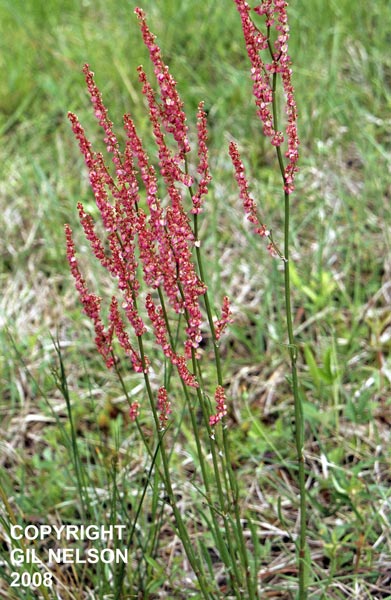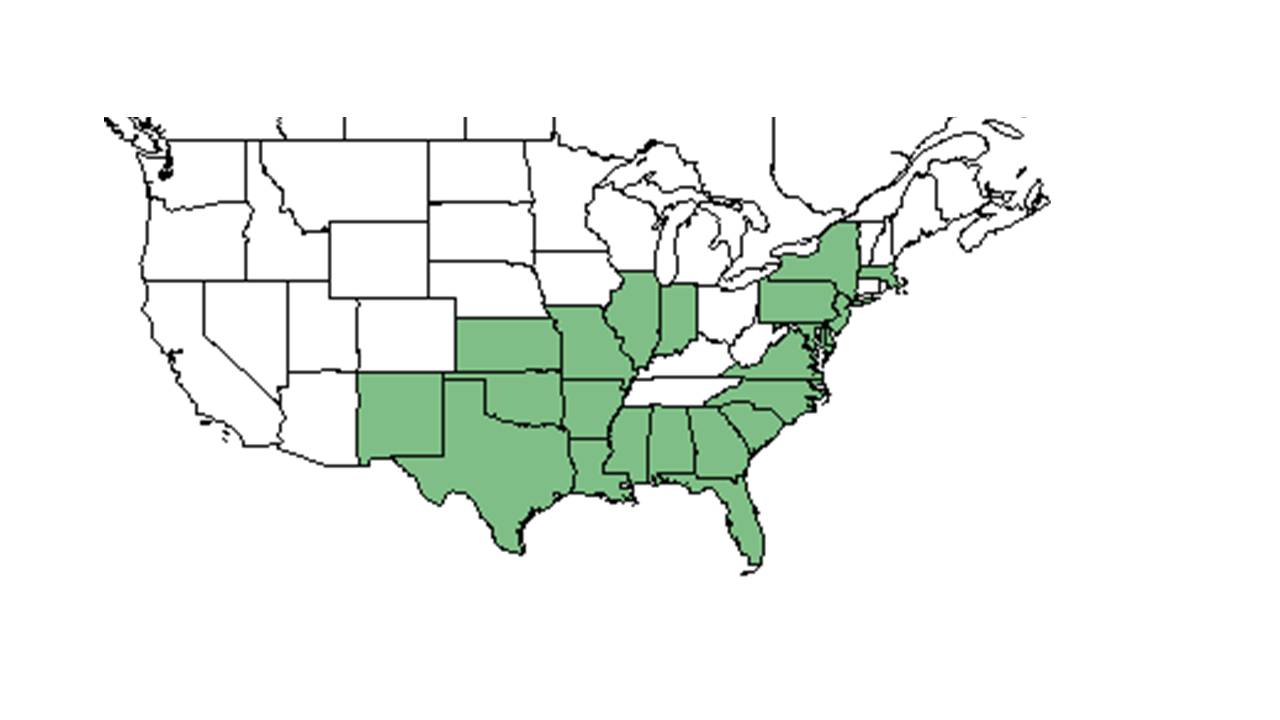Difference between revisions of "Rumex hastatulus"
HaleighJoM (talk | contribs) (→Ecology) |
|||
| (5 intermediate revisions by 3 users not shown) | |||
| Line 28: | Line 28: | ||
==Ecology== | ==Ecology== | ||
===Habitat=== <!--Natural communities, human disturbed habitats, topography, hydrology, soils, light, fire regime requirements for removal of competition, etc.--> | ===Habitat=== <!--Natural communities, human disturbed habitats, topography, hydrology, soils, light, fire regime requirements for removal of competition, etc.--> | ||
| − | ''R. hastatulus'' can be found in shortleaf pine-oak forests, back sides of foredunes, scrub edges, under magnolia islands in sand dune communities, sandy areas of upland mixed forests, mesic woodlands, rocky open woods, thickets, granite outcrops, upland sandhill pond basins. <ref name="FSU Herbarium">Florida State University Robert K. Godfrey Herbarium database. URL: [http://herbarium.bio.fsu.edu http://herbarium.bio.fsu.edu]. Last accessed: July 2015. Collectors: C. J. Hansen, C. M. Morton, John W. Carter, Jr., John W. Thieret, Delzie Demaree, Sidney McDaniel, S. B. Jones, Carleen Jones, R L Lazor, Fred B Jones, R. Kral, A. R. Diamond, Loran C. Anderson, K. Craddock Burks, Robert K. Godfrey, Jean W. Wooten, John C. Ogden, Gary R. Knight, N. J. Summerlin, D. B. Ward, R. R. Smith, B. Moore, D. Burch, Luis Almodovar, L B Trott, M. Knott, J. P. Gillespie, H. E. Grelen, Grady W. Reinert, Richard S. Mitchell, D. Burch, E. M. Hodgson, Elmer C. Prichard, Harry E. Ahles, J. Haesloop, C. R. Bell, M. P. Burbanck, R. C. Darby, H. L. Blomquist, Andre F. Clewell, D. C. Hunt, R. F. Doren, Roy Komarek, Lisa Keppner. States and Counties: Alabama: Houston, Lee, Pike, Arkansas: Columbia, Pike. Florida: Bay, Bradford, Calhoun, Franklin, Gulf, Jackson, Jefferson, Lafayette, Leon, Levy, Liberty, Madison, Marion, Orange, Polk, Santa Rosa, St Johns, Taylor, Volusia, Wakulla, Walton, Washington. Georgia: Chattahoochee, DeKalb, Fulton, Grady, Marion. Louisiana: Ouachita, Rapides. Mississippi: Forrest, Jasper. North Carolina: Bladen, Chatham, Durham. South Carolina: Cherokee. Texas: Refugio, San Patricio, Van Zandt. Compiled by Tall Timbers Research Station and Land Conservancy.</ref> It can also occur along roadsides, roadside depressions, recently tilled roadsides, lawns, open fields, recently cleared areas, swampy woodland clearings, cleared creek bottoms, sandy fallow fields, old biocontrol plots, and areas of frequently disturbed soils. <ref name="FSU Herbarium"/> Soils include sand, sandy loam, and loamy sand. <ref name="FSU Herbarium"/> | + | ''R. hastatulus'' can be found in shortleaf pine-oak forests, back sides of foredunes, scrub edges, under magnolia islands in sand dune communities, sandy areas of upland mixed forests, mesic woodlands, rocky open woods, thickets, granite outcrops, upland sandhill pond basins.<ref name="FSU Herbarium">Florida State University Robert K. Godfrey Herbarium database. URL: [http://herbarium.bio.fsu.edu http://herbarium.bio.fsu.edu]. Last accessed: July 2015. Collectors: C. J. Hansen, C. M. Morton, John W. Carter, Jr., John W. Thieret, Delzie Demaree, Sidney McDaniel, S. B. Jones, Carleen Jones, R L Lazor, Fred B Jones, R. Kral, A. R. Diamond, Loran C. Anderson, K. Craddock Burks, Robert K. Godfrey, Jean W. Wooten, John C. Ogden, Gary R. Knight, N. J. Summerlin, D. B. Ward, R. R. Smith, B. Moore, D. Burch, Luis Almodovar, L B Trott, M. Knott, J. P. Gillespie, H. E. Grelen, Grady W. Reinert, Richard S. Mitchell, D. Burch, E. M. Hodgson, Elmer C. Prichard, Harry E. Ahles, J. Haesloop, C. R. Bell, M. P. Burbanck, R. C. Darby, H. L. Blomquist, Andre F. Clewell, D. C. Hunt, R. F. Doren, Roy Komarek, Lisa Keppner. States and Counties: Alabama: Houston, Lee, Pike, Arkansas: Columbia, Pike. Florida: Bay, Bradford, Calhoun, Franklin, Gulf, Jackson, Jefferson, Lafayette, Leon, Levy, Liberty, Madison, Marion, Orange, Polk, Santa Rosa, St Johns, Taylor, Volusia, Wakulla, Walton, Washington. Georgia: Chattahoochee, DeKalb, Fulton, Grady, Marion. Louisiana: Ouachita, Rapides. Mississippi: Forrest, Jasper. North Carolina: Bladen, Chatham, Durham. South Carolina: Cherokee. Texas: Refugio, San Patricio, Van Zandt. Compiled by Tall Timbers Research Station and Land Conservancy.</ref> It can also occur along roadsides, roadside depressions, recently tilled roadsides, lawns, open fields, recently cleared areas, swampy woodland clearings, cleared creek bottoms, sandy fallow fields, old biocontrol plots, and areas of frequently disturbed soils. <ref name="FSU Herbarium"/> Soils include sand, sandy loam, and loamy sand.<ref name="FSU Herbarium"/> |
| − | Associated species include ''Liatris, Panicum, Leptoloma cognatum, Trifolium, Vicia, Linaria, Cerastium'' and ''Viola.'' <ref name="FSU Herbarium"/> | + | Associated species include ''Liatris, Panicum, Leptoloma cognatum, Trifolium, Vicia, Linaria, Cerastium'' and ''Viola.''<ref name="FSU Herbarium"/> |
===Phenology=== <!--Timing off flowering, fruiting, seed dispersal, and environmental triggers. Cite PanFlora website if appropriate: http://www.gilnelson.com/PanFlora/ --> | ===Phenology=== <!--Timing off flowering, fruiting, seed dispersal, and environmental triggers. Cite PanFlora website if appropriate: http://www.gilnelson.com/PanFlora/ --> | ||
| Line 38: | Line 38: | ||
<!--===Fire ecology===--> <!--Fire tolerance, fire dependence, adaptive fire responses--> | <!--===Fire ecology===--> <!--Fire tolerance, fire dependence, adaptive fire responses--> | ||
<!--===Pollination===--> | <!--===Pollination===--> | ||
| + | ===Herbivory and toxicology===<!--Common herbivores, granivory, insect hosting, poisonous chemicals, allelopathy, etc--> | ||
| + | Heavily grazed by deer.<ref name="FSU Herbarium"/> | ||
| + | <!--===Diseases and parasites===--> | ||
| − | === | + | ==Conservation, cultivation, and restoration== |
| − | + | ||
| − | + | ==Cultural use== | |
| − | + | The ''Rumex'' species can be cooked into a meal of greens or the new leaves could be pureed. In the past, it was kept as a potherb for this reason. Additionally, Native Americans would use the plant's seeds to create flour.<ref> Fernald, et al. 1958. Edible Plants of Eastern North America. Harper and Row Publishers, New York.</ref> | |
| − | |||
==Photo Gallery== | ==Photo Gallery== | ||
<gallery widths=180px> | <gallery widths=180px> | ||
Latest revision as of 11:35, 15 July 2022
| Rumex hastatulus | |
|---|---|

| |
| Photo taken by Gil Nelson | |
| Scientific classification | |
| Kingdom: | Plantae |
| Division: | Magnoliophyta – Flowering plants |
| Class: | Magnoliopsida – Dicotyledons |
| Order: | Polygonales |
| Family: | Polygonaceae |
| Genus: | Rumex |
| Species: | R. hastatulus |
| Binomial name | |
| Rumex hastatulus Baldw. | |

| |
| Natural range of Rumex hastatulus from USDA NRCS Plants Database. | |
Common names: Heartwing sorrel, Wild sorrel, Heartwing dock, Wild dock, Hastateleaf dock
Contents
Taxonomic notes
Synonym: Acetosa hastatula (Baldwin) Á. Löve
Description
A description of Rumex hastatulus is provided in The Flora of North America.
Distribution
Ecology
Habitat
R. hastatulus can be found in shortleaf pine-oak forests, back sides of foredunes, scrub edges, under magnolia islands in sand dune communities, sandy areas of upland mixed forests, mesic woodlands, rocky open woods, thickets, granite outcrops, upland sandhill pond basins.[1] It can also occur along roadsides, roadside depressions, recently tilled roadsides, lawns, open fields, recently cleared areas, swampy woodland clearings, cleared creek bottoms, sandy fallow fields, old biocontrol plots, and areas of frequently disturbed soils. [1] Soils include sand, sandy loam, and loamy sand.[1]
Associated species include Liatris, Panicum, Leptoloma cognatum, Trifolium, Vicia, Linaria, Cerastium and Viola.[1]
Phenology
R. hastatulus has been observed to flower from February to May with peak inflorescence in April and fruits in April.[1][2]
Herbivory and toxicology
Heavily grazed by deer.[1]
Conservation, cultivation, and restoration
Cultural use
The Rumex species can be cooked into a meal of greens or the new leaves could be pureed. In the past, it was kept as a potherb for this reason. Additionally, Native Americans would use the plant's seeds to create flour.[3]
Photo Gallery
References and notes
- ↑ 1.0 1.1 1.2 1.3 1.4 1.5 Florida State University Robert K. Godfrey Herbarium database. URL: http://herbarium.bio.fsu.edu. Last accessed: July 2015. Collectors: C. J. Hansen, C. M. Morton, John W. Carter, Jr., John W. Thieret, Delzie Demaree, Sidney McDaniel, S. B. Jones, Carleen Jones, R L Lazor, Fred B Jones, R. Kral, A. R. Diamond, Loran C. Anderson, K. Craddock Burks, Robert K. Godfrey, Jean W. Wooten, John C. Ogden, Gary R. Knight, N. J. Summerlin, D. B. Ward, R. R. Smith, B. Moore, D. Burch, Luis Almodovar, L B Trott, M. Knott, J. P. Gillespie, H. E. Grelen, Grady W. Reinert, Richard S. Mitchell, D. Burch, E. M. Hodgson, Elmer C. Prichard, Harry E. Ahles, J. Haesloop, C. R. Bell, M. P. Burbanck, R. C. Darby, H. L. Blomquist, Andre F. Clewell, D. C. Hunt, R. F. Doren, Roy Komarek, Lisa Keppner. States and Counties: Alabama: Houston, Lee, Pike, Arkansas: Columbia, Pike. Florida: Bay, Bradford, Calhoun, Franklin, Gulf, Jackson, Jefferson, Lafayette, Leon, Levy, Liberty, Madison, Marion, Orange, Polk, Santa Rosa, St Johns, Taylor, Volusia, Wakulla, Walton, Washington. Georgia: Chattahoochee, DeKalb, Fulton, Grady, Marion. Louisiana: Ouachita, Rapides. Mississippi: Forrest, Jasper. North Carolina: Bladen, Chatham, Durham. South Carolina: Cherokee. Texas: Refugio, San Patricio, Van Zandt. Compiled by Tall Timbers Research Station and Land Conservancy.
- ↑ Nelson, G. PanFlora: Plant data for the eastern United States with emphasis on the Southeastern Coastal Plains, Florida, and the Florida Panhandle. www.gilnelson.com/PanFlora/ Accessed: 13 DEC 2016
- ↑ Fernald, et al. 1958. Edible Plants of Eastern North America. Harper and Row Publishers, New York.